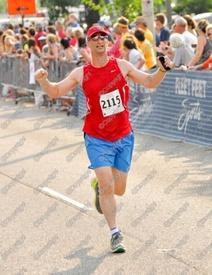Does the "fat burning" zone exist?

kassiebby1124
Posts: 927 Member
So with that whole idea of cardio and the ideal heart rates, why does it matter what percent your heart rate is? Apparently the "ideal" fat burning zone is 60-70%. My question is, if you were above 70 or whatever, shouldn't it burn MORE fat? I've been trying to research it and I'm still really confused.
0
Replies
-
You burn fat a lot of ways, but "fat burning zone" is a misnomer. You burn fat anytime your TDEE is more than what you consume. The reason why fat burning zone is misleading is because if you're in a deficit.. you're burning fat while you sit, sleep, exist etc. It should really be named "Low intensity cardio zone that builds only endurance."0
-
You burn fat a lot of ways, but "fat burning zone" is a misnomer. You burn fat anytime your TDEE is more than what you consume. The reason why fat burning zone is misleading is because if you're in a deficit.. you're burning fat while you sit, sleep, exist etc. It should really be named "Low intensity cardio zone that builds only endurance."
basically.0 -
I have the same questions. There's lots of research/evidence to both support and bunk the 'fat-burning zone'. I've found that when I'm only working at 60-70% I don't feel like I'm working all that hard.
I was talking to a relative (who has his PhD in Sports Nutrition and Exercise Physiology) and he was telling me that it's different for everyone. He explained that the best place to be is just when you can no longer breath through your nose but want to breath through your mouth to get more oxygen. For me, that place is about 70-75% of my maximum heart rate.
By the way, he also supports HIIT. You get the most benefit from the ramping up of your heart rate, and then keeping it at the elevated rate builds fitness and endurance.0 -
Fat burning is a result of a calorie deficit (in vs. out). So however you achieve that deficit (whether that be by eating fewer calories and/or exercising more), the bigger the deficit, the bigger the weight loss (hopefully fat).
I don't think I really know the answer to your question about heart rates. My common sense tells me that higher than 70 would burn more calories than 60 for the same time period. But maybe the idea is that 60-70 is sustainable for a longer workout?
I feel that the idea of a "fat burning zone" is misleading. Calories in/out is going to be the key for managing weight.
Heart rate might be more relevant for cardiovascular health/endurance.0 -
You burn different proportions of fat & glycogen at different intensities (lower intensity = more fat and less glycogen) but it actually doesn't matter at all from a viewpoint of total calories burned. Just keep in mind your calorie balance over the course of a day.
Heart rate zone training makes a difference in relation to training for different sports but for fat loss it's just the number of calories burned that are significant.0 -
It should really be named "Low intensity cardio zone that builds only endurance."
It would cost way too much money to reprint all those labels and resize the cardio machines so that phrase fits.0 -
I could not agree less with the one who said "My common sense tells me that higher than 70 would burn more calories than 60 for the same time period" I also personally believed that way.
By the way, I believe that if you couple cardio exercises with a proper diet, chances are you, getting good results. I have been trying what they call the paleo diet it is actually a diet patterned to ancient people's eating lifestyle , but honestly at first I thought that that it was just a fad, but I prove myself wrong. I just realized that ancient people are enjoying long and lean bodies because of what they eay.0 -
You burn different proportions of fat & glycogen at different intensities (lower intensity = more fat and less glycogen) but it actually doesn't matter at all from a viewpoint of total calories burned. Just keep in mind your calorie balance over the course of a day.
Heart rate zone training makes a difference in relation to training for different sports but for fat loss it's just the number of calories burned that are significant.
i'd say this is your best answer. THe way i learned it, you can only burn fat as a fuel source if you have oxygen in the cell to do so. when your heart rate goes up, you can't get the oxygen there fast enough to actually burn fat. And to be in that zone it would probably be a lot less then 70% of your MAX HR.
But, the higher the heart rate, the more intense the exercise, the more calories you will burn. Its better to just look at it in terms of energy used. use more energy then you take in and your body will have to get it from somewhere (fat).
So, technically, there is likely a way to burn more fat DURING exercise but you'll get much better results just maximizing calories burned.
So ultimately0 -
OK! What people have been saying is correct, if you are at a calorie deficit, then you will burn fat (with or without exercise).
Now the treadmill question, when you do any type of intensity workout where you raise the heart rate and require deeper breathing, you are basically requiring your body to go in what is called an aerobic respitory state.
So what does that mean and why is this important to burning fat?
When you do an intense exercise, your body quickly adapts and goes into the "oh crap, i need to feed energy into my muscles" mode. To quickly achieve this (the very first second you run on the treadmill and start hoofing it) your body reacts by grabbing the available creatine phosphate that exists around your fat and muscle cells. There's probably about enough of this high-energy compound to enable you to run on the treadmill for about a good 8-10 seconds. This is called the Phosphagen System. When this phosphate creatine runs out, your body then switches into what is called Glycogen-lactic acid system. Here your body then uses the available glycogen (a simple sugar your body produces from breaking down complex carbohydrates that you recently consumed). It uses this glycogen to feed the energy that your muscles need to continue to run on the treadmill. During Glycogen-lactic acid system, your body does not need oxygen to burn the glycogen, and all you are using is the reserves of glycogen that is in your body. (The byproduct of this conversion is lactic acid which causes your muscles to burn within 90 seconds).
But this will only last for about 80-200 seconds. Then you ran out of available glycogen. Now you are forced to burn sources of energy completly to create carbon dioxide as a waste product instead of the lactic acid. At this phase, it is called Aerobic Respiration. (cause you use oxygen to burn the chemicals). Now why is this so important? Cause you can now burn fatty acids that are in your body in this phase as well. This means, yup (fat burning mode). But your body just won't automatically burn fat. Your body has to be forced to burn fat by making sure you eat at a calorie deficit. Meaning, your body did not take in enough carbs (that you ate) so it cannot break these carbs down into simple sugars, so now it has to go grab it from fatty acids (you also run the small risk from having muscle tissue used as well). You know you are reaching this phase because your heart beats faster and you are breathing much heavier.
So I would say they call it the fat burning mode because this is the minimal effort to get your body into an aerobic respitory state (if you do it for at least 2 minutes). It is a misnomer because your body won't automatically burn fat in this phase if you consumed enough carbs to where your body has a nice supply of sugar in the blood stream. But if you run long enough and use of all your supply, then your body will have no other choice than to start burning fat.
Now obviously if you can make your heart go even faster by running faster, you will use up even more energy during aerobic respiration. But the "fat burning" mode is just the minimal amount of exertion your body will go into this aerobic respiration. if you go any slower, they are suggesting that you are not working your body enough to raise your heart levels nor use up the other systems before aerobic activity.
I have a nice website reference that explains the systems better and in more depth.
http://health.howstuffworks.com/wellness/diet-fitness/exercise0 -
During Glycogen-lactic acid system, your body does not need oxygen to burn the glycogen, and all you are using is the reserves of glycogen that is in your body. (The byproduct of this conversion is lactic acid which causes your muscles to burn within 90 seconds).
But this will only last for about 80-200 seconds. Then you ran out of available glycogen. Now you are forced to burn sources of energy completly to create carbon dioxide as a waste product instead of the lactic acid.
There's something wrong with this. Glycogen stores last a lot longer than 1-3 minutes. the liver alone stores somewhere between 50-100 grams of glycogen (depending on which source is correct). That equates to between 200-400 calories.
When endurance athletes talk about "hitting the wall", that's due to glycogen depletion. That happens after a few hours, not minutes.0 -
Every home has a fat burning zone. It's called the kitchen. Of course, it only works if you stay out of it. :bigsmile:0
-
During Glycogen-lactic acid system, your body does not need oxygen to burn the glycogen, and all you are using is the reserves of glycogen that is in your body. (The byproduct of this conversion is lactic acid which causes your muscles to burn within 90 seconds).
But this will only last for about 80-200 seconds. Then you ran out of available glycogen. Now you are forced to burn sources of energy completly to create carbon dioxide as a waste product instead of the lactic acid.
There's something wrong with this. Glycogen stores last a lot longer than 1-3 minutes. the liver alone stores somewhere between 50-100 grams of glycogen (depending on which source is correct). That equates to between 200-400 calories.
When endurance athletes talk about "hitting the wall", that's due to glycogen depletion. That happens after a few hours, not minutes.
I am talking about the reserves of glycogen that are nearby the muscle cells that don't require oxygen to burn. Sorry about that. After about 2 minutes, your body will then use oxygen to burn other sources of glycogen, fatty acids, and even protein (muscle). The process is complex so I am very over simplifying it. But the point I really want to make is, under ~2 minutes the body doesn't require oxygen. After that, the body does require oxygen and then you can start burning fatty acids if the body was in the situation where it had to.
If you run/walk slower than the "fat burning zone", what that is suggesting (not sure if entirely true tho) your body is not working hard enough to get into the state where oxygen is required so it cannot burn fatty acids.0 -
You burn different proportions of fat & glycogen at different intensities (lower intensity = more fat and less glycogen) but it actually doesn't matter at all from a viewpoint of total calories burned. Just keep in mind your calorie balance over the course of a day.
Heart rate zone training makes a difference in relation to training for different sports but for fat loss it's just the number of calories burned that are significant.
i'd say this is your best answer. THe way i learned it, you can only burn fat as a fuel source if you have oxygen in the cell to do so. when your heart rate goes up, you can't get the oxygen there fast enough to actually burn fat. And to be in that zone it would probably be a lot less then 70% of your MAX HR.
But, the higher the heart rate, the more intense the exercise, the more calories you will burn. Its better to just look at it in terms of energy used. use more energy then you take in and your body will have to get it from somewhere (fat).
So, technically, there is likely a way to burn more fat DURING exercise but you'll get much better results just maximizing calories burned.
So ultimately
Ditto on both accounts...0 -
During Glycogen-lactic acid system, your body does not need oxygen to burn the glycogen, and all you are using is the reserves of glycogen that is in your body. (The byproduct of this conversion is lactic acid which causes your muscles to burn within 90 seconds).
But this will only last for about 80-200 seconds. Then you ran out of available glycogen. Now you are forced to burn sources of energy completly to create carbon dioxide as a waste product instead of the lactic acid.
There's something wrong with this. Glycogen stores last a lot longer than 1-3 minutes. the liver alone stores somewhere between 50-100 grams of glycogen (depending on which source is correct). That equates to between 200-400 calories.
When endurance athletes talk about "hitting the wall", that's due to glycogen depletion. That happens after a few hours, not minutes.
I am talking about the reserves of glycogen that are nearby the muscle cells that don't require oxygen to burn. Sorry about that. After about 2 minutes, your body will then use oxygen to burn other sources of glycogen, fatty acids, and even protein (muscle). The process is complex so I am very over simplifying it. But the point I really want to make is, under ~2 minutes the body doesn't require oxygen. After that, the body does require oxygen and then you can start burning fatty acids if the body was in the situation where it had to.
If you run/walk slower than the "fat burning zone", what that is suggesting (not sure if entirely true tho) your body is not working hard enough to get into the state where oxygen is required so it cannot burn fatty acids.
Okay, I guess that could make sense, although this is the first time I've ever heard that concept.
But if this whole concept is correct, wouldn't that mean it would be impossible to burn fat without exercise?0 -
But if this whole concept is correct, wouldn't that mean it would be impossible to burn fat without exercise?
Couple of things, I said the treadmill is suggesting that you couldn't burn fat. I caveat with (not sure if entirely true tho) .
The other thing is, you are constantly breathing in oxygen, so it is being used somewhere for normal resting state activity.
But when you exercise, your body goes into the (oh crap I need to feed those specific muscle groups some extra energy).
Then you go into the 3 phases I described in that order.
If you don't exercise, it becomes as simple as, 1) how many calories did I eat today? 2) how many calories did my body require today? 3) which is bigger? 4a) if calories eaten is bigger, store the extra as fat 4b) if calories used is bigger, then go grab what I need from fat
Your body loves carb calories (eaten) the best because it is the most simple way for your body to convert into energy. Simple sugars first, then complex carbohydrates. If you body has to rely on fatty acids or proteins, then the body has to go into much more complex systems and has to work harder to burn energy. I am not even going to try to explain what these systems are. lol
But yeah, your body can burn fat without exercise. The answer is outside the scope of the question.
The question asked specifically why is there a "fat burning zone" on the treadmill and can I still burn fat if I ran faster and harder?
My answer addressed that specific question, not how does the body burn fat in general.0
This discussion has been closed.
Categories
- All Categories
- 1.4M Health, Wellness and Goals
- 398.1K Introduce Yourself
- 44.7K Getting Started
- 261K Health and Weight Loss
- 176.4K Food and Nutrition
- 47.7K Recipes
- 233K Fitness and Exercise
- 462 Sleep, Mindfulness and Overall Wellness
- 6.5K Goal: Maintaining Weight
- 8.7K Goal: Gaining Weight and Body Building
- 153.5K Motivation and Support
- 8.4K Challenges
- 1.4K Debate Club
- 96.5K Chit-Chat
- 2.6K Fun and Games
- 4.8K MyFitnessPal Information
- 12 News and Announcements
- 21 MyFitnessPal Academy
- 1.5K Feature Suggestions and Ideas
- 3.2K MyFitnessPal Tech Support Questions











